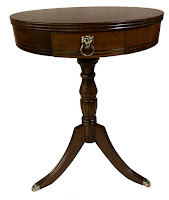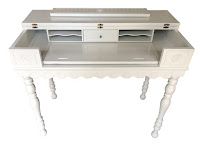 |
| Rocking Chair After |
 |
| Rocking Chair Before |
This was a very old rocking chair that belonged to my customer’s grandfather. It had plenty of use and had seen better days, so it was in need of some TLC. The right arm had broken off the spindle and needed to be glued back into place prior to any refinishing work being done.
She had wanted to keep the same color, so we decided to go with traditional walnut, which brought out the beauty of the solid oak wood, refreshing the overall look and making it once again a beautiful piece of furniture.
Like most old rocking chairs, this one had a very badly worn seat which had the original horsehair stuffing and some very unusable other materials. The dust was enough to make me sneeze! My customer had chosen a fabric similar in color to the original, which was a lovely dark olive velour, to keep the original look and feel of the chair. Jim was kind enough to remove the old fabric, since I was still recovering from my stomach surgery and he took plenty of photos for reference. I have found taking photos to be an essential part of reupholstery disassembly, because you need to know how it was put together, before you take it apart and reassemble it properly, and photos are a great way to accomplish this.
The springs on this seat were installed from the bottom side, downward. I have worked on a few chairs like this and always wondered the reason for this type of installation of springs. For a chair to be comfortable, you have to have a “crown,” which is a curved top so that the springs are underneath you, covered by layers of various materials so you don’t feel the springs. Installed from the underside of the seat seems backward and puts more stress on the springs, since they can’t really support you properly. Since I have been doing reupholstery, I have learned the proper way to attach webbing to the underside of the chair and hand-stitch each spring to the webbing using a curved needle, then using the 8-way tie to keep the springs tight, creating the “crown” chairs should have for support.
After the springs are tied up and in securely in place, they get covered with upholstery burlap. This is the first layer to cover the springs. Since this chair had only five springs, I built-up the in-between spring area with a bit of raw cotton to keep everything level and soft. Next I covered the springs with a one inch layer of foam, which gets stapled to the chair’s seat edges, covering the springs. On top of the foam, I covered everything with a 1” layer of Dacron. This is a more dense material and really does a great job of covering the springs so you don’t feel them at all. My last covering was a high-quality layer of muslin. This keeps everything neat and makes it easier to attach the fabric, the last step in the process.
This chair originally had tacks along the bottom edge, but they weren’t the correct upholstery tacks. Someone used regular tacks that you’d use on a bulletin board, which are not adequate for chair use. I used brass upholstery tacks on the folded underside edge of the material so it will not fray. My final step for the fabric was to finish it with a double-cording on the chair’s arms and back spindles. This adds a nice finishing touch and secures the edges of the material.
The last step of the process is to cover the underside of the chair with chambray to cover the webbing and keep the dust out. It is also referred to as the dust cover on chairs and couches. This finishes off the chair and looks great.
Below I have a few photos of the springs’ underside tying and correct 8-way tying so you can see how much better it looks. I’m not really sure what the reason is to do it the underside way, but the way I’ve been self-taught is to use the 8-way tie on the topside of the chair.
 |
Underseat tying,
incorrect way |
 |
8-way tie
correct way |



















































